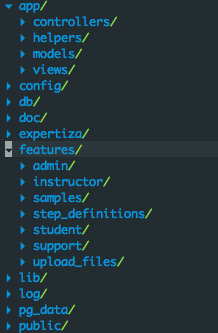CSC/ECE 517 Spring 2013/OSS E600: Difference between revisions
| Line 83: | Line 83: | ||
=== File Organization === | === File Organization === | ||
Before there were 35 feature files. They have been consolidated to 20 files. The largest improvement is the feature folder 'student' as shown below: | Before there were 35 feature files. They have been consolidated to 20 files. The largest improvement is the feature folder 'student' as shown below: | ||
[[http://wiki.expertiza.ncsu.edu/images/5/5a/Before.PNG]] | [[File:http://wiki.expertiza.ncsu.edu/images/5/5a/Before.PNG]] | ||
=== Coverage Increase === | === Coverage Increase === | ||
Revision as of 02:34, 21 March 2013
OSS E600
Writing Assignment 2
Work in progress. Due 3/20/2013
Introduction
There were three goals in the OSS E600 project <ref name='assignment'> http://courses.ncsu.edu/csc517/common/homework/OSS/expertiza.html</ref>
- Restructure the feature files for better organization. Feature folders like 'student' had few scenarios strung out between many files. Reconsolidate the files to make them more useful.
- Determine a gem that will generate code coverage reports. It needs to work with Ruby 1.8.7 and Rails 2.
- Use the coverage tool to find areas that need the most improvement. Then create new tests targeting those areas to increase coverage.
Setup
Setting up the coverage + cucumber environment is very similar to setting up for only cucumber. The majority of the instructions in the old cucumber wiki still apply.<ref name='old_wiki'>http://wiki.expertiza.ncsu.edu/index.php?title=Using_Cucumber_with_Expertiza</ref>
Follow the linux wiki to setup Expertiza. Assuming that Expertiza is already running, enter these commands:
gem install relevance-rcov bundle install rake db:create rake db:test:prepare
Modify the file ./lib/task/cucumber.rake. Add the line "t.rcov=true" below each of the three t.profile lines.
Cucumber::Rake::Task.new({:ok => 'db:test:prepare'}, 'Run features that should pass') do |t|
t.binary = vendored_cucumber_bin # If nil, the gem's binary is used.
t.fork = true # You may get faster startup if you set this to false
t.profile = 'default'
t.rocv = true #add this line for coverage report
end
Cucumber::Rake::Task.new({:wip => 'db:test:prepare'}, 'Run features that are being worked on') do |t|
t.binary = vendored_cucumber_bin
t.fork = true # You may get faster startup if you set this to false
t.profile = 'wip'
t.rocv = true #add this line for coverage report
end
Cucumber::Rake::Task.new({:rerun => 'db:test:prepare'}, 'Record failing features and run only them if any exist') do |t|
t.binary = vendored_cucumber_bin
t.fork = true # You may get faster startup if you set this to false
t.profile = 'rerun'
t.rocv = true #add this line for coverage report
end
Running
Run Coverage and All Features
Enter the command below to run the entire cucumber feature suite and get code coverage reports.
rake features
Run All Features <ref name='old_wiki'/>
To run all cucumber features found within the ./features directory:
bundle exec cucumber
Run a Single Feature <ref name='old_wiki'/>
To run all scenarios for a single cucumber feature:
bundle exec cucumber features/admin/impersonate_user.feature
Run a Single Scenario <ref name='old_wiki'/>
To run specific scenario within a feature, specify the line number:
bundle exec cucumber features/admin/impersonate_user.feature:5
Coverage Reports
The coverage reports will be generated in the folder ./coverage. <ref name='rcov'> https://github.com/cucumber/cucumber/wiki/Using-RCov-with-Cucumber-and-Rails </ref> The reports will be in an HTML format. View the report by opening ./coverage/index.html in a browser.
- <put screenshot of directory here with index.html selected>
- <put screenshot of output here>
Design Patterns
The work that we did in implementing this project did not introduce any new design patterns to the Expertiza system that were of our own creation.
The Cucumber system, however, does exhibit the Facade Pattern. The Facade Pattern provides a simplified interface to a software system. The Cucumber package provides this facade through the steps in Capybara. The simplified interface allows the software developer to write tests in something close to a natural language.
Outcome
File Organization
Before there were 35 feature files. They have been consolidated to 20 files. The largest improvement is the feature folder 'student' as shown below: File:Http://wiki.expertiza.ncsu.edu/images/5/5a/Before.PNG
Coverage Increase
References
<references/>
